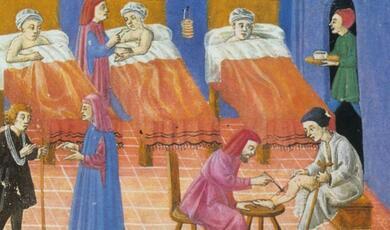Mathematics in the modern age - The 19th century: Revolution or evolution?
Share
- Details
- Text
- Audio
- Downloads
- Extra Reading
What is a number? Can you solve a quintic equation? Is Euclid true? And is the calculus correct? The 19th century witnessed major breakthroughs in geometry, algebra and calculus, and a move 'back to basics'. But were these the results of continual change, or did they indicate a revolution in the subject?
Download Text
MATHEMATICS IN THE MODERN AGE – THE 19TH CENTURY: REVOLUTION OR EVOLUTION?
Professor Robin Wilson
Introduction
In my last lecture, on the 18th century, we saw the devastating influence of Isaac Newton on British mathematics, holding it back for more than a hundred years while advances were being made on the Continent by such ‘greats’ as the Bernoulli brothers, Leonhard Euler, and Lagrange and Laplace. If you felt that I placed too much emphasis on 18th-century activities in Britain, rather than the Continent, this was partly because I’ll redress the balance in my lectures on the numbers ‘e’ and ‘i’ and on Euler next year, and partly because today’s lecture also focuses on events on the Continent ― mainly in France and Germany.
In this lecture I’ll be looking at developments in four main areas – algebra, various types of geometry, calculus, and the foundations of mathematics. For each one I’d like you to consider whether each of these was a revolution in thought or simply a natural evolution from earlier work. But first, let’s go to France.
France
Out of the turbulent years of the French Revolution and the rise to power of Napoleon Bonaparte came several important developments in mathematics. Napoleon himself was an enthusiast for mathematics and its teaching, and there are even a couple of results in geometry known as ‘Napoleon’s theorem’.
One of Napoleon’s greatest supporters was the geometer Gaspard Monge, who accompanied him on the Egyptian expedition of 1798. Monge taught at a military school, where he studied the properties of lines and planes in 3-dimensional geometry. While investigating possible positionings for gun emplacements in a fortress, he greatly improved on the known methods for projecting 3-dimensional objects on to a 2-dimensional plane; this subject became known as ‘descriptive geometry’.
An important consequence of the French Revolution was Napoleon’s founding of the École Normale and the École Polytechnique in Paris. There the country’s finest mathematicians, including Monge, Laplace, Lagrange and Cauchy, taught the students who were destined to serve in both military and civilian capacities. The textbooks produced by the teachers at the École were later to be widely used in France and the United States.
Projective geometry
For many 19th-century mathematicians, the most basic and important type of geometry was projective geometry or the study of perspective. This topic, which had its origins in early Renaissance painting, had been developed by such practitioners as Brunelleschi and della Francesca in Italy and Albrecht Dürer in Germany.
In the 16th century such concerns became the province of practical tradesmen whose crafts involved perspective (such as architects and military engineers), as well as of theoretical mathematicians such as Girard Desargues (who discovered a celebrated result on triangles in perspective). After this, projective geometry went underground for about 150 years, before emerging with a vengeance around 1800 in post-Revolutionary France.
Gaspard Monge’s skill as a teacher at the new École Polytechnique helped to establish descriptive geometry and to inspire his talented students. Although his approach was highly practical, he also developed the necessary algebraic machinery to make the subject versatile and rewarding.
His most talented student was Jean Victor Poncelet, the ‘father’ of modern projective geometry. While languishing in jail during Napoleon’s invasion of Russia, Poncelet developed the idea of a ‘projective transformation’ and studied the properties of figures that remain unchanged under them. This work was influenced by that of Monge and Desargues, but much of it was intuitive and unrigorous and was not well received by the mathematical powers-that-be in Paris, such as Cauchy.
But one idea that was truly revolutionary was that of duality, a real break with the past. Poncelet took a conic, such as an ellipse, and selected a point outside it (called a pole), drew tangents to the conic, and joined the points where the tangents meet the conic; he obtained a line called apolar. As he moved the pole along a line, he obtained different lines all passing through the same point. Using this idea he was able to take general theorems about points lying on lines and recast them as theorems about lines passing through points – prove one theorem and get another one for free!
Other French mathematicians, such as Gergonne, tried to carry this idea to its logical conclusion, claiming that points and lines should be regarded as interchangeable concepts with the same logical status:
any two points determine a line; any two lines determine a point.
(This is not our usual Euclidean geometry, where two lines determine a point only when they are not parallel.) This idea was as profound as it was controversial, but it caused difficulties which the French mathematicians were unable to resolve.
The scene next moved to Germany, where Möbius and others attacked the problem using algebra, much as Descartes had done two centuries earlier when he introduced coordinates x and y in order to solve the geometrical problem of Pappus. (Möbius was the mathematician and astronomer after whom the one-sided Möbius strip is named.)
Möbius’s idea of 1827, which he called his ‘barycentric coordinates’, was essentially to represent each point, not by two coordinates [a, b], but by three [a, b, c], determined only up to its multiples – so that [1, 2, 3] and [2, 4, 6] are the same point – and to represent lines by equations of the form ax + by + cz = 0, instead of the usual ax + by = c. The duality between points and lines is then very simple:
[a, b, c] ↔ ax + by + cz.
These algebraic ideas proved to be highly successful and were developed by several mathematicians, mainly in Germany.
Algebra
Meanwhile, back in France, there were important developments in algebra, concerning the solution of equations.
Since Mesopotamian times, people had been able to solve what we now call ‘quadratic equations’, using only arithmetic operations and square roots, and using a method called ‘completing the square’; this idea was later developed by Islamic scholars such as al-Khwarizmi in his algebra book, the one whose title contained the word ‘al-jabr’. Nowadays we often express the solution of quadratic equations in terms of the ‘quadratic equation formula’.
In the 16th century Italian mathematicians learned how to solve cubic equations (equations of degree 3). Again we can express the solutions in terms of arithmetic operations and extracting roots (this time, square roots and cube roots). They were also able to solve quartic equations (those of degree 4), by reducing them to cubic ones which they could then solve; again, there are formulas (very complicated ones!) for the solutions involving the arithmetical operations and extracting roots.
But how about equations of degree 5 or more? The search for a general solution or formula for these occupied the finest mathematicians, such as Descartes and Euler, but little progress was made until Lagrange attempted the problem, laying the groundwork for the eventual solution.
Lagrange’s first approach was as follows. Given a cubic equation such asx3 + nx + p = 0, we can substitute x = y – n/(3y) and the equation becomes
y6 + py3 – 1/27n3 = 0.
This is a quadratic equation in y3 that we can solve; the six values for ygive six values of x, but these turn out to be equal in pairs, so we get just three values for x, as expected.
Similarly, given a quartic equation x4 + nx2 + px + q = 0, we can reduce it to the equation
y3 – 1/2n – qy + 1/8(4nq – p2) = 0.
This is a cubic equation that we can solve, and we eventually obtain the required values for x.
Lagrange found that this approach would not work for equations of higher degree, such as the quintic equation of degree 5, so he took another approach. Suppose that we are given the cubic equation
x3 + ax2 + bx + c = 0,
and that its solutions are p, q and r, so that
x3 + ax2 + bx + c = (x – p) (x – q) (x – r).
If we multiply out the right-hand side, we find that the constant term c is –pqr, the x-term b is pq + pr + qr, and the x2-term a is – (p + q + r). Each of these is symmetrical in p, q and r, which means that if we permute p, q and r in any way we like, we get just one possible value in each case. But if we take a different expression, such as pq + 2r, we don’t get different values when we permute p and q and leave r – in fact, we can get just three different values:
pq + 2r, pr + 2q and qr + 2p.
Or if we take p + 2q + 5r, we get six different values. So the number of possible different values can vary, but it always divides 6 – and in general, if we have an equation of the nth degree, rather than a cubic, then the number of different values we can obtain always divides n!. This result later became known in a more general setting as Lagrange’s theorem for groups.
This idea of permuting the solutions and counting the number of different values was taken up by Paolo Ruffini, who made the bold claim in a book that:
The algebraic solution of equations of degree greater than 4 is always impossible. Behold a very important theorem which I believe I am able to assert (if I do not err); to present the proof of it is the main reason for publishing this volume. The immortal Lagrange, with his sublime reflections, has provided the basis of my proof.
Unfortunately, Ruffini’s proof contained a gap, and it was left to others to continue the work.
It was not until the 1820s that a proof finally emerged, that
there is no general method, or formula, for solving equations of degree 5 or more.
This was obtained by the Norwegian mathematician Niels Henrik Abel, developing the above ideas of Lagrange.
Abel had a short and tragic life. Growing up in Norway, he was desperate to study in the centres of mathematical life, France and Germany. He was eventually able to spend a little time in both countries, in Paris and Berlin, and contributed several works to a new mathematical journal founded in Germany by his friend Crelle; among these was his proof of the impossibility for solving the quintic equation. He returned to Norway where he contracted tuberculosis and died at the age of only 26. Two days later a letter arrived at his home offering him a professorship at Berlin.
Abel’s work was continued by the brilliant young French mathematician Évariste Galois, who obtained criteria for deciding which quintic and other equations can be solved. These ultimately led to whole new areas of algebra, now known as group theory and Galois theory.
Galois also had a short and tragic life, dying in a duel of honour at the age of 20. A firebrand who became involved following the July Revolution of 1830, he threatened the life of the Orléanist king, Louis-Phillippe, but was acquitted. A month later he appeared on Bastille Day in the uniform of the banned Artillery guard and carrying several weapons, whereupon he was thrown into jail. The night before his duel, arising from his supposed involvement with a young lady, he frantically wrote out his mathematical achievements for posterity, but it was some years before anyone could appreciate what they meant and what a genius the world had lost.
Non-Euclidean geometry
Euclid’s Elements are built on five ‘postulates’, or self-evident truths. Four of these are straightforward, such as the assumption that a circle can be drawn with any given centre and radius. However, the fifth postulate is different in style, resembling a theorem that ought to be provable from the others. It states that if two lines include angles x and y whose sum is less than 180°, then these lines must meet if extended indefinitely.
Over the centuries many mathematicians tried to prove the fifth postulate, often by recognising other results and proving them equivalent to it; it is then sufficient to prove any one of the other results. The most familiar of these is the so-called ‘parallel postulate’, that given any line l and any point p not lying on l, there is a line parallel to l that passes through p. Another equivalent result is that the angles of any triangle add up to 180 degrees.
The first really significant advance appeared in the book Euclid vindicated, written by the Italian Gerolamo Saccheri in 1733. He considered a geometry in which the parallel postulate is not assumed, and he considered the sum of the angles in a triangle.
If the angle-sum is 180°, we get Euclid’s geometry. Saccheri proved that if the angle-sum is more than 180° then we get a contradiction – the parallel postulate can be proved both true and false, so there is nogeometry with this property. Finally, he tried to repeat the process for triangles with angle-sum less than 180°, but he was unable to do so. If he had been successful, the parallel postulate would then have been deducible from the other axioms, showing that Euclid’s geometry is the only one.
Saccheri was proved wrong in spectacular fashion. Around 1830, working independently in Russia and Hungary, Nikolai Lobachevsky and János Bolyai were able to construct a geometry in which the angle sum of every triangle is less than 180°. This geometry satisfies the first four postulates, but not the fifth one, and is a very strange geometry. For a start, given any line l and any point p not lying on l, there are infinitely many lines through p which are parallel to l. Also, if two triangles are similar (that is, they have the same angles), then they are congruent – and that’s certainly not true in Euclidean geometry.
The existence of such ‘non-Euclidean geometries’ was very controversial. Gauss claimed to have constructed one, but typically hadn’t published his results. When his friend Farkas Bolyai, János’s father, informed Gauss of his son’s success, Gauss dismissed the results out of hand, saying that he had discovered the same thing many years earlier; the Bolyais never forgave him for this.
Sadly, Bolyai and Lobachevsky never enjoyed the credit due to them for their spectacular discovery, for it was not until after their deaths that their geometry was understood and generalised.
In particular, the German mathematician Bernhard Riemann (of Riemann hypothesis fame) studied some generalised ideas of distance and curvature in the 1850s, and then used these to obtain infinitely many different geometries, each one equally valid and each one a candidate for the physical space we live in; indeed, it was one of these geometries, rather than Euclidean geometry, that proved to be the natural setting for Einstein’s theory of relativity many years after Riemann’s death. This was truly a revolution of deepest significance in the way we think about the world around us.
By 1870 the world of geometry had become very confused. In addition to the wealth of non-Euclidean geometries, there were the Euclidean and projective geometries and many others besides. The remaining years of the century saw many attempts to sort out the mess and to put the various geometries on a firm axiomatic foundation.
The most famous of these attempts was the so-called Erlanger Programm of the German geometer Felix Klein, proposed at his inaugural lecture at the University of Erlangen in 1872. Klein described a geometry in general terms as a set of points (such as those in the plane) with a collection of transformations on them – for example, Euclidean geometry consists of the transformations that do not change an object’s size and shape, such as rotations, reflections and translations.
If we now allow more transformations (for example, we could scale the object up or down), we obtain geometries in which fewer properties are preserved – for example, in projective geometry all triangles are the same. By such considerations Klein was able to classify all geometries and to prove the surprising result that, in some sense, every geometry is contained inside projective geometry.
From calculus to analysis
In my last lecture we saw the problems caused by the lack of rigour in the calculus of Newton and Leibniz, and by Bishop Berkeley’s criticism of their work. Basically, the problem arose when they considered a tiny quantity which at one stage they assumed was non-zero and at a later stage they took to be zero.
Various mathematicians tried to rescue the situation. In particular, the French mathematician Jean d’Alembert tried to introduce the idea of a ‘limiting process’ in which the small quantity gets smaller and smaller and shrinks to zero, but he was not fully successful. Indeed, success had to wait until around 1820 with the work of two men, Bernard Bolzano of Prague and Augustin-Louis Cauchy of the École Polytechnique in Paris.
In 1817, Bolzano produced a pamphlet that gave a purely analytic proof of the theorem that, between any two values that give a result of opposite sign, there lies at least one real root of the equation. This result is now called the ‘intermediate value theorem’, and tells us that if we have a continuous graph that at one place is below the x-axis and at another is above it, then at some point in between it must cross the x-axis. Although this is obvious intuitively, it had never been rigorously proved before. Unfortunately, like Abel, Bolzano lived far from the mainstream of mathematical activity and his work was largely ignored.
But things were happening in Paris. In 1821, Cauchy produced a book Cours d’Analyse, in which he formalised the idea of a limit, saying:
When the values successively attributed to the same variable approach a fixed value indefinitely, in such a way as to end up by differing from it as little as we could wish, this last value is called the limit of all the others …
Using this idea of a limit, Cauchy was able to transform the whole subject. He gave, for the first time, rigorous explanations of what it means to say that a graph is continuous (no gaps) and smooth (no corners). He also gave a rigorous presentation of the two fundamental concepts of the calculus, which we now call differentiation and integration.
As the century progressed, Cauchy’s ideas were developed by other people. They were also stretched to the limit (!) as various ‘awkward’ curves were discovered that needed very careful study. One of these has the remarkable property that it is continuous everywhere (that is, it has no gaps in it), and yet it is jagged everywhere (every point is a corner). It is made up from sawtooth patterns and is often called the blancmange function because it looks like a pudding; Ian Stewart has described it as ‘a trifle unorthodox’.
Fundamentals
As mathematics developed in so many ways, its practitioners found it increasingly important to define all terms precisely, and the 1860s witnessed an examination of the very fundamentals of the subject: mathematicians were even asking such basic questions as What is a number?
We’re all familiar with the natural numbers 1, 2, 3, …: we’ve used these for counting since earliest times. After several millennia there appeared the number zero and the negative numbers, giving us the integers..., – 3, – 2, – 1, 0, 1, 2, 3, 4,.. .
We next come across the rational numbers: these are fractions of the form a/b, where a is an integer and we can take b to be a natural number (since we mustn’t divide by 0). But even here we have to be careful: the fractions 1/2, 2/4 and 3/6 are all different, yet they represent the same rational number, and in calculations we don’t always use the simplest form: when calculating 1/2 + 1/3, we first replace 1/2 by 3/6 and 1/3 by 2/6 in order to find their sum 5/6.
But the big question that arose in the nineteenth century is: what exactly is a real number? These are all the points that lie on a line, but how do we actually define them? We might try to introduce the irrational numbers, such as √2 or π, but they won’t help us unless we can also say what an irrational number is.
It’s not difficult to prove that every rational number can be written as a finite or recurring decimal fraction; for example, 1/8 = 0.125, 1/3 = 0.333… and 1/7 = 0.14285714285714… We can also go the other way and prove that every finite or recurring decimal can be written as a fraction. So we might try to define the irrational numbers like √2 or π as infinite decimals that don’t recur.
At one level this answers the difficulty – we can now say that a number is a decimal: finite, recurring or infinite as the case may be. But we then run into trouble when we try to do arithmetic, because if we define √2 to be the infinite decimal 1.414213…, then how do we prove that √2 × √2 = 2 (try multiplying two infinite decimals together!).
Much time was spent in the second half of the nineteenth century sorting out such difficulties. The German mathematician Georg Cantor and others introduced set theory, starting from a few basic undefined terms such as a set and an element of a set.
By developing mathematics as a hierarchical structure based on sets and elements, just as Euclid had built up geometry from the undefined notions of point and line, he hoped to remove all difficulties – indeed, by the end of the century Moritz Pasch and David Hilbert had succeeded in formalising the Euclidean, projective and non-Euclidean geometries. That such a move was ultimately to fail is something we’ll see next time.
I’d like to end with one more result of Cantor, one that was truly revolutionary. This was the idea that some infinities are larger than others. This idea had its origins in the musings of Galileo over 300 years earlier, who had noticed that there are far fewer perfect squares 1, 4, 9, 16, … than natural numbers 1, 2, 3, …, and yet we can match them up exactly:
1 ↔ 1, 2 ↔ 4, 3 ↔ 9, 4 ↔ 16, etc.
We can also match the natural numbers with some larger sets, such as the integers. We simply list them in the order:
0, 1, –1, 2, –2, 3, –3, 4, etc.
Notice that every integer occurs somewhere in the list – none is omitted.
Cantor’s amazing discovery was that we can also list all the rational numbers in order, so that the set of all rational numbers has ‘the same size’ as the set of all natural numbers, even though it seems so much bigger. However, as Cantor proved, the set of all real numbers cannot be made to match up with the natural numbers, and so must be a ‘bigger’ infinite set. It follows that some infinite sets are genuinely bigger than others: not all infinities are the same.
Indeed, to take his idea further, we can find infinitely many different infinities, all of different sizes – an intriguing thought to finish on. There had indeed been a revolution in mathematics in the 19th century.
© Professor Robin Wilson, Gresham College, 25 October 2006
This event was on Wed, 25 Oct 2006
Support Gresham
Gresham College has offered an outstanding education to the public free of charge for over 400 years. Today, Gresham College plays an important role in fostering a love of learning and a greater understanding of ourselves and the world around us. Your donation will help to widen our reach and to broaden our audience, allowing more people to benefit from a high-quality education from some of the brightest minds.


 Login
Login







